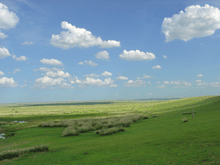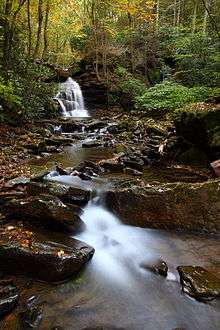Wallpaper (computing)

A wallpaper or background (also known as a desktop wallpaper, desktop background, desktop picture or desktop image on computers) is a digital image (photo, drawing etc.) used as a decorative background of a graphical user interface on the screen of a computer, mobile communications device or other electronic device. On a computer it is usually for the desktop, while on a mobile phone it is usually the background for the 'home' or 'idle' screen. Though most devices come with a default picture, users can usually change it to custom files of their choosing.
"Wallpaper" was the term used in Microsoft Windows before Windows Vista (where it is called the "desktop background"), while Mac OS X calls it "desktop picture". (Previously, the term desktop pattern was used to refer to a small pattern that was repeated to fill the screen.)
Wallpaper images are usually copyrighted as many other digital images found on the Internet, and as such, most websites collecting and sharing wallpapers, as well as the users downloading from them are an example of mass copyright infringement, a phenomenon which challenges the meaning and illegality of digital piracy and the validity of current copyright legislation around the world.
History

The X Window System was one of the earliest systems to include support for an arbitrary image as wallpaper via the xsetroot program, which at least as early as the X10R3 release in 1985 could tile the screen with any solid color or any binary-image X BitMap file. In 1989, a free software program called xgifroot was released that allowed an arbitrary color GIF image to be used as wallpaper, and in the same year the free xloadimage program was released which could display a variety of image formats (including color images in Sun Rasterfile format) as the desktop background. Subsequently, a number of programs were released that added wallpaper support for additional image formats and other features, such as the xpmroot program (released in 1993 as part of fvwm) and the xv software (released in 1994).
The original Macintosh operating system only allowed a selection of 8×8-pixel binary-image tiled patterns; the ability to use small color patterns was added in System 5 in 1987.[1] MacOS 8 in 1997 was the first Macintosh version to include built-in support for using arbitrary images as desktop pictures, rather than small repeating patterns.[2]
Windows 3.0 in 1990 was the first version of Microsoft Windows to come with support for wallpaper customization, and used the term "wallpaper" for this feature.[3] Although Windows 3.0 only came with 7 small patterns (2 black-and-white and 5 16-color), the user could supply other images in the BMP file format with up to 8-bit color (although the system was theoretically capable of handling 24-bit color images, it did so by dithering them to an 8-bit palette).[4] to provide similar wallpaper features otherwise lacking in those systems. A wallpaper feature was added in a beta release of OS/2 2.0 in 1991.[5]
Due to the widespread use of personal computers, some wallpapers have become immensely recognizable and gained iconic cultural status. Bliss, the default wallpaper of Microsoft Windows XP has become the most viewed photograph of the 2000s.[6]
Live wallpaper

A 'live wallpaper' is a type of application that works on a mobile device using the Android operating system. The application works as a wallpaper – providing the background image for the home screen—but also works as a conventional application since it can provide user-interaction with the touch screen (allowing the image to change dynamically, for example) and access other hardware and software features within the device (accelerometer, GPS, network access, etc.).[7]
Similar functionality could be found in the Active Desktop feature of Windows 98 and later versions. There is also third party software that provides this feature for various operating systems.
Mobile wallpaper
A mobile wallpaper is a computer wallpaper sized to fit a mobile device such as a mobile phone, personal digital assistant or digital audio player. The height is often greater than or equal to the width. Wallpapers can typically be downloaded at no cost from various websites for modern phones (such as those running Android, iOS, or Windows Phone operating systems). Modern smartphones allow users to use photos from the web; or photographs captured with a phone's camera can be set as a wallpaper.
Dynamic backgrounds
In OS X
OS X has built-in support, via the Desktop & Screen Saver panel in its System Preferences, for cycling through a folder collection of images on a timed interval or when logging in or waking from sleep.
Additionally, OS X has the native ability to run a screen saver on the desktop; in this configuration, the screen saver appears beneath the desktop icons in place of the system wallpaper. However, OS X does not come with a built-in interface to do this; it must be done through Terminal commands or various third-party applications.[8]
In Windows 7, 8, 8.1 and 10
Similarly, Windows can also be set to cycle through pictures from a folder at regular intervals. It is supported on Windows 7, Windows 8, Windows 8.1, Windows 10.
If fully animated backgrounds are wanted, third party software would need to be installed.
In GNOME
GNOME 2 also can be set to cycle through pictures from a folder at regular intervals, similarly to Windows 7.
In KDE 4
KDE 4 provides this feature as well (slideshow).
In Enlightenment
Enlightenment v17 supports image sequences, animated and interactive desktop backgrounds in its default configuration.
In Android
Live wallpaper have been introduced in Android 2.0 (Eclair) and later versions. The live wallpaper is an animated, interactive background that can react and change to input, like touch or data.
In iOS
Dynamically animated backgrounds have also been introduced in iOS 7 and later versions, however they are restricted to the ones provided by Apple. Jailbroken iOS devices can download other dynamic backgrounds.
Other systems or window managers
For other systems, a third party software is required[9] (* in development).
| Typical Wallpaper Sizes | ||
|---|---|---|
| Aspect Ratio | Width x Height | Phone models |
| 1:1 | 128x128 |
|
| 130x130 |
| |
| 320x320 |
| |
 |
120x160 |
|
| 132x176 |
C75,CX65,CX70(emoty),CX75,M65,M75,S65,SK65,S75,SL75 | |
| 240x320 |
Most mobile phones. | |
| 360x480 |
| |
 |
128x168 |
|
| 176x208 |
| |
| Others | 96x65 |
|
| 101x80 |
| |
| 120x143 |
| |
| 176x220 |
MPx200, V80, V300, V400, V500, V600
| |
| 208x320 |
| |
| 240x400 |
| |
| 462x200 | ||
| 320x480 |
| |
| 480x320 |
| |
| 480x360 |
| |
| 640x360 |
| |
| 640x960 |
| |
| 16:9 | 1080x1920 | |
See also
References
- ↑ Robert R. Wiggins, "All systems go. (Software Review) (System Tools 5.0 with MultiFinder.)", MacUser (1 March 1988)
- ↑ Franklin N. Tessler, "Mac OS 8 arrives," Macworld (1 September 1997)
- ↑ Gus Venditto, "Windows 3.0 brings icons, multitasking, and ends DOS's 640k program limit," PC Magazine (1 July 1990)
- ↑ Charles Petzold, "Working with 24-bit color bitmaps for Windows," PC Magazine (10 September 1991)
- ↑ Wendy Goldman, "New version may tiop scales in IBM's favor over DOS, Windows: A look at OS/2 2.0," Computer Reseller News (24 June 1991)
- ↑ Sweeney, Cynthia (March 26, 2014). "Say goodbye to 'Bliss'". St. Helena Star. Retrieved May 19, 2014.
- ↑ "Live Wallpapers (Technical Article)". developer.android.com. Retrieved 5 November 2010.
- ↑ Set a Screen Saver as the Desktop Background | Terminal. Mac OS X Tips (2006-11-09). Retrieved on 2013-07-21.
- ↑ lunemec/wpchanger 路 GitHub. Github.com. Retrieved on 2013-07-21.
- ↑ "iPhone Screen Resolutions". iphoneresolution.com.
- ↑ "HTC One (M8) Specs and Reviews - HTC United States". HTC.
- ↑ Mat Smith. "LG G2 review". Engadget. AOL.
- ↑ "Sony Xperia Z Rivals and Competitors". Phone Arena.
- ↑ John Howell. "World beating 1080p high resolution HTC J Butterfly phone - Science Fiction World". sciencefictionworld.com.
- ↑ "Samsung Galaxy S4 specs". Phone Arena.
External links
| Wikibooks has more on the topic of: Wallpaper (computing) |
| Wikimedia Commons has media related to Computer wallpaper. |